|

by Alfred Lambremont Webre
Seattle Exopolitics Examiner
March 14, 2010
from
Examiner Website
Researcher
Richard C. Hoagland, a pioneer
champion of
NASA Viking Orbiter satellite
photos of the
Face on Mars as evidencing the
product of an intelligent Martian civilization, recently drew a
public line in the scientific sand regarding the evidence for the
presence of current indigenous, intelligent life on Mars.
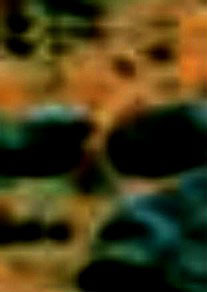
NASA/Andrew D.
Basiago - Humanoid on Mars
In a March 8, 2010 email dialogue sponsored by Robert Morningstar,
editor of
UFO Digest on the subject of current Martian life, Mr.
Hoagland stated,
“Evidence... Show me evidence of
CURRENT ‘intelligent life on Mars.’ All we see are ruins...
literally thousands of square miles... of ruins. And, a lot of
mud covering them... slowly eroding and blowing away in the
wind. Which is why we can now see glimpses [of] what was once
buried in a vast, planetary catastrophe, which suddenly ENDED
the Martian Civilization... a long, long time ago."
Richard C. Hoagland
P.S. If there is anyone NOW
living on Mars, it is ‘us’ - as part of the ~60-year-old
Secret
Space Program.
A new generation of data from Mars
supporting the existence of indigenous intelligent and animal
Martian life have been emerging
-
from the
NASA Mars Rovers, which
have been on the Martian surface photographing it at close
range
-
from
independent whistleblowers
from compartmentalized secret U.S. government Mars programs
Application of the law of witness and
documentary evidence may be a methodology leading to breakthroughs
in evaluating this new generation of data now emerging regarding the
existence of indigenous, intelligent and animal extraterrestrial
life on Mars, our nearest planetary neighbor.
This Examiner article explores the application of the law of
evidence to the question of proving the existence of contemporary
intelligent life indigenous to Mars.
How to
Evaluate The Evidence for Indigenous Martian Intelligent Life
See pdf file “How
to Evaluate The Evidence for Indigenous Martian Intelligent Life”.
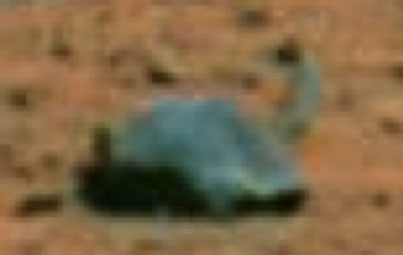
NASA/MARS: Rover
10214
Land-based
plesiosaur-like reptile, back to camera, neck forward
Proof of the
Existence of Martian Intelligent Life
Just as Richard C. Hoagland says that the available evidence proves
there is no current indigenous intelligent life on Mars (other than
the secret U.S. space program), it is possible to present proof of
the opposite of that assertion - i.e. that there is intelligent
indigenous Martian life currently on Mars.
All sides of the conversation about the existence of indigenous
Martian intelligent life deserve to be respectfully heard according
to the methodology of the law of evidence.
Evidence & the Burden of Proof - The
principle of reasonableness
-
Witness evidence
One source summarizes the
principles of the law of witness evidence
as follows:
-
"In systems of proof based
on the English common law tradition, almost all evidence
must be sponsored by a witness, who has sworn or
solemnly affirmed to tell the truth.
The bulk of the law
of evidence regulates the types of evidence that may be
sought from witnesses and the manner in which the
interrogation of witnesses is conducted during direct
examination and cross-examination of witnesses.
Other
types of evidentiary rules specify the standards of
persuasion (e.g., proof beyond a reasonable doubt) that
a trier of fact such as a jury must apply when it
assesses evidence."
-
Documentary evidence
Documentary, including
photographic evidence can be treated, according to one
source,
as follows:
-
"Evidence of an indirect
nature which implies the existence of the main fact in
question but does not in itself prove it. That is, the
existence of the main fact is deduced from the indirect
or circumstantial evidence by a process of probable
reasoning. The introduction of a defendant's
fingerprints or DNA sample are examples of
circumstantial evidence.
The fact that a defendant had a
motive to commit a crime is circumstantial evidence. It
is possible to argue that all evidence is ultimately
circumstantial, on the premises that no experience
whatsoever can directly prove a fact. Recall, however,
that courts of law deal with what is reasonable, not
with
ontology."
-
“The principal questions of
ontology are ‘What can be said to exist?’ and ‘Into what
categories, if any, can we sort existing things?’”
The Hoagland-Van Flandern Fallacy
The Hoagland-Van Flandern
fallacy, a term coined by researcher Andrew D. Basiago,
refers to the fallacy behind the mutual argument of Mr. Hoagland and
deceased astronomer
Thomas C. Van Flandern (1940-2009)
that an intelligent indigenous Martian civilization evidenced by
monuments such as the
Face on Mars at Cydonia does not exist on Mars
at present, as the civilization behind the Mars face died out a very
long time ago.
Richard C. Hoagland has (reportedly) called this reporter (Alfred
Lambremont Webre) "crazy" before on George Noory's
Coast to Coast AM for asserting
that indigenous, intelligent Martians - more probably than not -
currently exist on the surface of Mars and beneath Mars.
The evidence for this assertion I cited
in my own appearance before the 4.5 million nightly listeners of the
Coast to Coast AM audience was the documentary evidence of recent
NASA Rover Spirit photos and witness evidence of independent
whistleblowers
Arthur Neumann and Andrew D Basiago,
both of whom say they have been to U.S. bases on Mars and met
contemporary Martians. (George Noory respectfully allowed me to
present the MARS findings on Coast-to-Coast AM).
Whistleblower
evidence - An intelligent Martian
civilization
Mr.
Andrew D. Basiago, a
Cambridge-trained environmentalist and attorney, has publicly
confirmed that in 1970, in the company of his late father, Raymond
F. Basiago, an engineer for The Ralph M. Parsons Company who
worked on classified aerospace projects, he met three Martian
astronauts at the Curtiss-Wright Aeronautical Company facility in
Wood Ridge, New Jersey while the Martians were there on a liaison
mission to Earth and meeting with US defense-technical personnel.
Witness evidence - DARPA Project
Pegasus Time Travel and Teleportation & life on Mars
Andrew D. Basiago’s witness evidence reveals the fact that by 1968
the US intelligence community may have been already aware of aspects
of his later Mars work.
Mr. Basiago tells of seven briefings
over 40 years in which he was shown evidence of his destiny
involving the discovery of indigenous life on Mars, and explains how
the emergence of time travel and this epochal future event were
interlinked.
As a result of this quantum access, Andy
was given a copy of his landmark paper
The Discovery of Life on Mars
in 1971 and asked to read
and remember it, so that when, in 2008, he wrote it, it would
contain as much data about Mars as possible.
Corroborating witnesses
Mr. Basiago’s training, his
witness evidence says, culminated in 1981, when, as a
19-year-old, he teleported to Mars, first by himself after being
prepared for the trip by CIA officer Courtney M. Hunt, and then a
second time in the company of Hunt.
Both trips, Mr. Basiago said, were made
via a “jump room” located at a CIA facility in El Segundo, CA. The
apparent purpose of the trips to Mars was to familiarize him with
Mars because the CIA knew of his destiny as the discoverer of life
on Mars and deemed it important that he visit Mars and experience it
first-hand.
Mr. Basiago’s involvement in US time-space research as a child, as
well as Courtney M. Hunt’s identity as a CIA officer, have been
confirmed by Dr. Jean Maria Arrigo, an ethicist who works
closely with US military and intelligence agencies, and by US Army
Captain Ernest Garcia, whose storied career in US
intelligence included both serving as a guard on the Dead Sea Scroll
expeditions of Israeli archaeologist Yigal Yadin and as the
Army security attaché to DARPA’s Project Pegasus.
Independent Mars whistleblower witness
On July 25, 2009, at the European Exopolitics Congress in Barcelona,
former DOD scientist Arthur Neumann
publicly stated,
“There is life on Mars. There are
bases on Mars. I have been there.”
The following day, Mr. Neumann
participated in Futuretalk, a
Project Camelot documentary interview,
in which he provided details of his teleporting to a base on Mars
and participating in a one-hour project meeting, which was also
attended by representatives of an intelligent civilization that
lives in cities under the surface of Mars.
Arthur Neumann has stated that he
teleported to Mars in order to participate in a project meeting
there at which Martian extraterrestrials were present.
Presentation of Documentary Evidence -
Rover Spirit Photos
Mr. Basiago has indicated that at public presentations of the MARS
findings, he averages about 75% of the audience who can cognize and
see some of the indigenous Martian humanoids, animals, structures,
and statues embedded in NASA Rover photos.
At the Nov. 2009 Barcelona Science and Spirit Conference
presentation by this reporter, 50% of the audience who polled as
being able to recognize the indigenous Martian intelligent and
animal life forms in the documentary evidence contained in the
PowerPoint in this article. (See video of presentation by clicking
here). Therefore one can say that the probable existence of
indigenous intelligent Martian life was proven for 50% of the
audience at Barcelona.
Why for not a greater percentage of the audience? Well, there is the
matter of NASA interference with the rover Spirit photos: NASA's
Seven Deadly Sins of Data Distortion.
NASA's Seven
Deadly Sins of Data Distortion
MARS’ president Andrew D. Basiago has catalogued seven techniques
that NASA is using to distort its data:
-
Scale - Compress vertical and
horizontal dimension to make everything look ordinary
-
Contrast - Set light-and-dark
ratio to extreme value or invert light and dark aspects
altogether
-
Color - Add false hues and
unnatural colors
-
Skew - Move forms out of vertical
alignment
-
Consistency - Paint over to make
a solid color look black, white, or opaque
-
Integrity - Alter natural forms
to look like forms that do not occur naturally
-
Content - Embed content with
altered contrast, non-human data, and strange pixels
Documentary evidence from NASA Rover photo
PIA10214
Evaluating The Evidence for Indigenous
Martian Intelligent Life
The basic standard in evaluating witness and documentary evidence in
the common law is the standard of “reasonableness.”
When a jury is a
court of common law is determining a question of fact, as to whether
contemporary indigenous Martian life exists, the members of the jury
use the standard of reasonableness in weighing direct and expert
witnesses, and documentary evidence.
The standard of reasonableness
can be stated as “what would a reasonable person conclude?”
Evaluating the witness evidence for
Indigenous Martian Intelligent Life
-
Evidence of Andrew D. Basiago
The witness evidence of Andrew D. Basiago as to indigenous
Martian intelligent life both on the surface and under the
surface of Mars, it seems to me, is highly credible. I have
had the opportunity to interview, question and cross-examine
Mr. Basiago closely over all aspects of his accounts
regarding Project Pegasus and Mars since the year 2000.
I have found his verbal and
written accounts to be consistent and verified by available
witness and documentary evidence, including written versions
of his evidence that he has made available to me. As an
attorney (Member of the District of Columbia bar) myself, I
have found Mr. Basiago, who is an attorney and graduate of
Cambridge University, to be extremely conscientious in his
duty as an officer of the court and a member of the Bar of
the state of Washington.
I have found him to consistently
tell the truth punctiliously, and to be a conscientious
reporter of his activities. The professional penalties for
an officer of the court in the state of Washington engaging
in a public deception or fraud regarding an issue of public
importance such as U.S. secret bases on Mars and personal
knowledge of indigenous Martian intelligent life could be
high.
There are credible, corroborating scientific, academic, and
U.S. intelligence witnesses of Mr. Basiago’s participation
in Project Pegasus, and of his two teleportations to U.S.
bases on Mars, where he encountered Martian life forms (see
PowerPoint) on the Martian surface.
-
Witness testimony of Arthur
Neumann
In Barcelona, Spain (July 25-26, 2009), this
reporter personally examined former DOD scientist Arthur
Neumann’s official U.S. passport credentials as a former
U.S. DOD scientist and National Security Agency retirement
pamphlets, and questioned him as to his teleportation
experience to Mars and his project meeting with Martian
extraterrestrials on Mars.
Mr. Neumann is an independent whistleblower who has made his
account - of teleporting to Mars and meeting Martian
extraterrestrials in a DOD-related project meeting on Mars –
public at great personal cost. He is a highly gifted and
intelligent scientist, and this reporter’s questions of him
and his account, I find it reasonable to conclude that he is
being truthful about his experiences and that the evidence
of his account as a genuine experience is reasonable.
Mr. Neumann and Mr. Basiago to my knowledge have not yet met
and have not had personal contact with each other.
Evaluating the documentary evidence for
Indigenous Martian Intelligent Life
A representative sample of
documentary evidence supporting the existence of indigenous Martian
intelligent life: “How
to Evaluate The Evidence for Indigenous Martian Intelligent Life”.
This
documentary evidence consists of images enhanced from selected
portions of NASA Rover Spirit photo PIA 10214, a composite photo
taken of the Columbia Basin on Mars (about the equivalent Martian
latitude of Columbus, Ohio) in November 2007 and released by NASA
onto the Internet in January 2008.
These enhanced images are documentary evidence of indigenous Martian
intelligent and animal life on the surface of Mars. This reporter
first began examining these images on December 7, 2008, in Portland,
Ore., when he was invited personally by witness Andrew D. Basiago to
examine images he was then first finding in NASA Mars Rover photo PIA 10214
(below image).
As this reporter can attest, viewing and cognizing these often novel
and strange Martian life forms requires imagination and persistence
by the earthling human observer. The immediate visibility and
discernability of this documentary evidence of indigenous Martian
intelligent and animal life should improve with advanced
photo-analysis techniques.
One expert witness to NASA Rover Mars photos (such as PIA 10214 -
below image)
whom this reporter has spoken to has reportedly analyzed over 4000
NASA photos, as well as the evidentiary documents in document.

Large file
http://photojournal.jpl.nasa.gov/jpeg/PIA10214.jpg
very large image (39.2 MB)
HERE
She states that NASA manipulates scale, contrast, color,
skewing, consistency, integrity, content, and up to five levels of
image within of NASA Rover photos to conceal indigenous intelligent
Martian life on Mars surface.
Individual MARS evidentiary documents
Each of the samples of documentary evidence, as photographed by the Mars Rover Spirit in Nov.
2007 in PIA 10214 from the Martian surface, seems to contain
reasonable representations of indigenous intelligent or animal life
on the surface of Mars.
Each of these documents falls within the scientific rubric of the
evidence of the documentation of new apparent life forms on a
neighboring planet – Mars – using a new, advanced technology - the
NASA Mars Rover.
Unlike the earlier generation of Viking Orbiter
satellites, which photographed the Martian surface from orbit around
Mars, the Mars Rovers can capture photographic close-ups, as well as
composite landscapes of Mars, which contain images of apparent
indigenous Martian life forms.
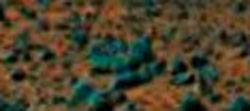
NASA/Andrew D.
Basiago - Two insect-human hybrids,
scorpion-like body, human-like head, shoulders, arms
An evaluation of each sample of the MARS
documentary evidence reveals the following
-
Documentary evidence from NASA
PIA10214: Figure of Humanoid Being (in center of photo
leaning on rocks with back to Rover camera) in the Rock
Enclosure on Tsiolkovski Ridge, Columbia Basin, Mars.
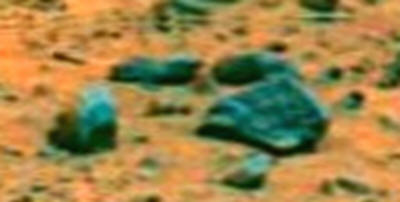
This
is a classic enhancement from NASA Rover photo PIA 10214.
One of the documents at
www.projectmars.net contains a step-by-step instruction in
how to locate this enhancement using your own desktop or
laptop computer and a copy of NASA photo PIA 10214. The figure of a Martian humanoid being has
his back facing the Rover Spirit camera, and is leaning on
the middle rock wall of the 3-wall rock enclosure, as though
on his knees.
The human appears to be
masculine, and has spindly, flesh colored arms and legs and
has a large, oval flesh-colored head, almost in the shape of
some of the grey extraterrestrial archetypes. He appears to
be dressed, to this reporter, in turquoise colored
spandex-type pants.
This is a reasonable conclusion
this reporter has reached after multiple viewings of this
particular document since Dec. 2008.
-
Documentary evidence from NASA
PIA10214: Figure of insect-human hybrid The Scorpion Man
(See insert) in the Turquoise Field, Columbia Basin, Mars.
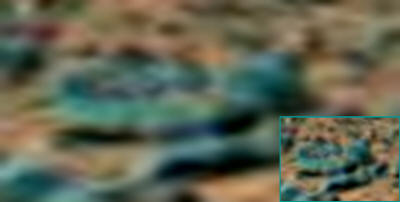
This enhancement of an apparent Martian life form found on
the Columbia Basin on Mars within NASA Rover photo PIA 10214
is a new species, that at first glance may grate our own
earthling sensitivities.
The documentary evidence appears
to portray an apparent insect - human hybrid, that has been
dubbed “the Scorpion Man”. In the original evidentiary
document containing both images and analysis derived from
NASA Rover photo 10214, insect-human hybrids and
lizard-human hybrids are among the apparent new species that
appear in NASA Rover photo PIA 10214.
In this document, two
insect-human hybrids each with a turquoise scorpion-like
body and an apparent flesh colored human-like head are
resting next to each other on the Mars terrain.
This reporter takes no position
on the biology of an insect-human hybrid, which the new
science of exobiology obviously must address. As an
observer, this reporter can reasonably conclude that the
NASA Rover photograph indeed depicts a new species of
apparent insect-human hybrid.
This is a reasonable conclusion
this reporter has reached after multiple viewings of this
particular document since Dec. 2008.
-
Documentary evidence from NASA
PIA10214: A second category of animal species on Mars
combines the elements of animal species that inhabit Earth
at this time in its biological history and that from our
perspective are hybrids of living animal species, such as
one animal species on Mars that combines the bodily shape of
an octopus with the face of a lion or a dog and that is
terrestrial rather than aquatic in nature.

This documentary evidence is an
image enhanced from NASA Rover Spirit photo 10214 that
depicts an apparent hybrid animal resting on the Martian
terrain of the Columbia Basin in November 2007 and looking
toward the NASA Rover camera. As in the case of the
insect-human hybrid, this Martian hybrid animal is unlike
any animal we know of Earth.
This reporter can reasonably
conclude that the documentary evidence is an exhibit of an
octopus-like land animal, perhaps furry, with facial
features that may be reptilian, feline, or canine in nature.
This is a reasonable conclusion this reporter has reached
after multiple viewings of this particular document since
Dec. 2008.
This reporter takes no position
on the biology of this Martian animal hybrid, which the new
science of exobiology obviously must address.
-
Documentary evidence from NASA
PIA10214: The third category includes reptile species
extinct on Earth. In this category we can place land-based
Martian species of the plesiosaur, which has often been
proposed as a solution to the Loch Ness, Lake Champlain, and
Lake Okanagan mysteries.
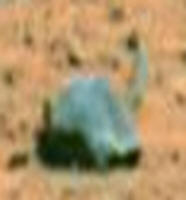 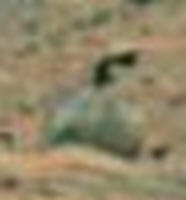 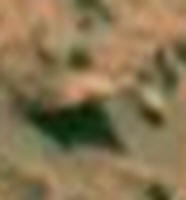
A reptile with a bulky body like
a tortoise and a long neck like a snake, plesiosaurus is
quite common on Mars but did not survive the
K-T extinction
on Earth.
The documentary evidence for this reptile Martian
species is contained in enhancements of NASA Rover photo
10214 of the Columbia Basin, Mars.
In the PowerPoint, three
evidentiary images of the Martian land-based plesiosaur from
PIA10214 are provided. In the left-side image, the
plesiosaur has its back facing toward the NASA Rover camera,
so that its bulky body is visible from the rear, and one can
see its elongated, curved neck and head in front of the
animal.
In the center photo, the Martian
plesiosaur is facing the NASA Rover Spirit camera, and its
head is tilted slightly towards its left, with its arching
neck visible curving down towards it bulky reptilian body.
The right-most photo is the image of the carcass of an
apparent dead Martian plesiosaur, lying on the Martian
terrain in the Columbia basin, as its was photographed by
the NASA Rover Spirit in November 2007.
After examination of the
documentary evidence, this reporter can reasonably conclude
that it accurately represents the image of actual living
Martian plesiosaur-like animals in the Columbia Basin in
November 2007.
The original research paper containing
documentary images and photos from NASA Rover photo 10214
contains some analysis as to the reasons why reptilians like
the Martian plesiosaur may have survived on Mars, and not on
Earth, which suffered a K-T extinction event.
The documentary evidence
supporting the existence of a land-based Martian plesiosaur
is reinforced by direct witness evidence of Mr. Basiago who
states that he and CIA agent Courtney M. Hunt were both
chased by a Martian plesiosaur that they encountered on the
Martian terrain during Mr. Basiago and Mr. Hunt’s mutual
teleportation to Mars in 1981.
Mr. Basiago has related that
he and Mr. Hunt had to take quick refuge in the surface
entrance to a U.S. base on Mars. This is a reasonable
conclusion this reporter has reached after multiple viewings
of this particular document since Dec. 2008.
This reporter takes no position
on the biology of this Martian plesiosaur, which the new
science of exobiology obviously must address.
Reasonable implications deduced from
witness & documentary evidence as to indigenous, intelligent Martian
life
In the opinion of this reporter, the witness and documentary
evidence meet the standard of reasonability and more probably than
not demonstrate the existence of contemporary indigenous Martian
intelligent and Martian life.
To wit:
-
Mars is - more probably than not
- an inhabited planet
The evidence suggests Mars surface
is fragile post collapse ecology, inhabited by humanoid and
animal life. There is prima facie witness evidence to
support a conclusion that a sub-surface contemporary
indigenous intelligent Martian civilization exists.
-
Indigenous intelligent Martian
life exists - more probably than not
The evidence suggests
Mars surface is inhabited by humanoid beings like and unlike
us and by animals that are like those that exist on Earth at
this time, that once existed on Earth in pre- historic
times, or that are hybrids with the traits of two or more
Earth species.
-
Hybrid human and animal Martian
species exist - more probably than not
The evidence
suggests that animal species on the surface of Mars include
human-insect hybrids and human-lizard hybrids that do not
exist on Earth and that to our knowledge have never existed
on Earth.
A human note - Mars, Richard C. Hoagland
and Andrew D. Basiago
Asked to comment on the significance of Mr. Hoagland's Mars research
as compared to his, Mr. Basiago said,
"I was once asked at a conference to
compare myself to Richard Hoagland. I responded:
'He is the Frank Lloyd Wright of
Mars anomaly research, and I am its Buckminster Fuller.'
By that I meant that Richard has
made the lifelong comprehensive contribution to our field, and
is regarded as the preeminent figure in the field, much as
Wright was regarded in the field of architecture.
I have made a very significant
contribution to the field of a more singular nature, that is,
the discovery of life on Mars, much as Fuller was responsible
for bringing the geodesic dome to architecture. Others may
disagree, but that is how I see it.
I would be less than humble were I
not to credit Richard for his 30-year campaign to focus public
attention on the existence of ancient artifacts on Mars and the
Masonic conspiracy within NASA, which are major parts of the
cosmic jigsaw puzzle that we are all trying to piece together.
Likewise, it is now incumbent on
Richard to acknowledge my discovery and show that Mars is big
enough not only for him and me but for the literally millions of
individuals who will be exploring and discovering things on Mars
in the 21st century!"
|










